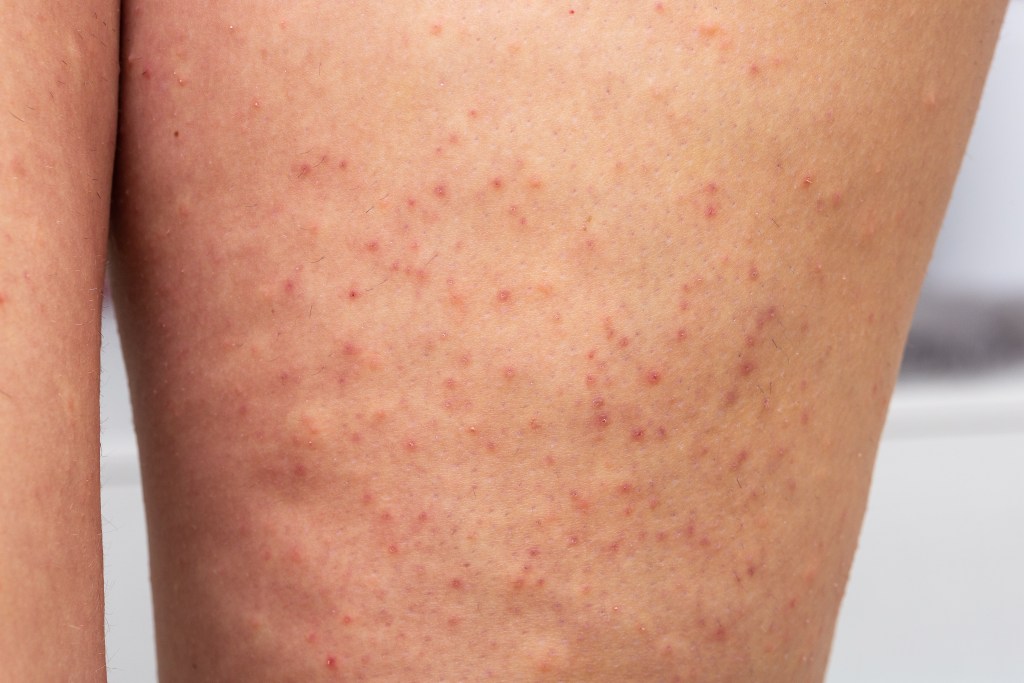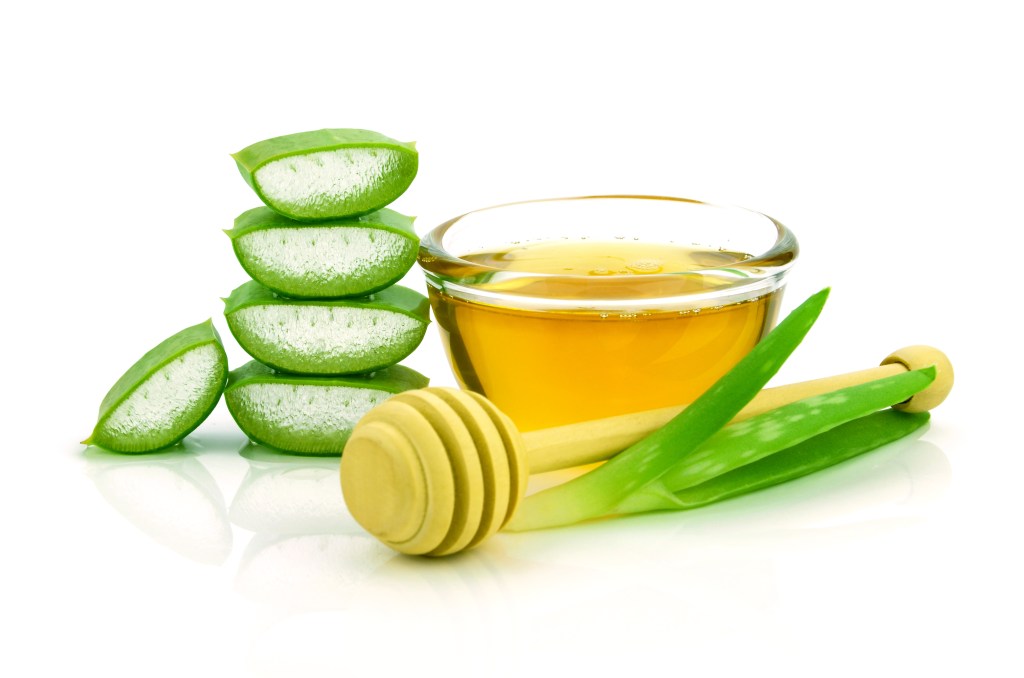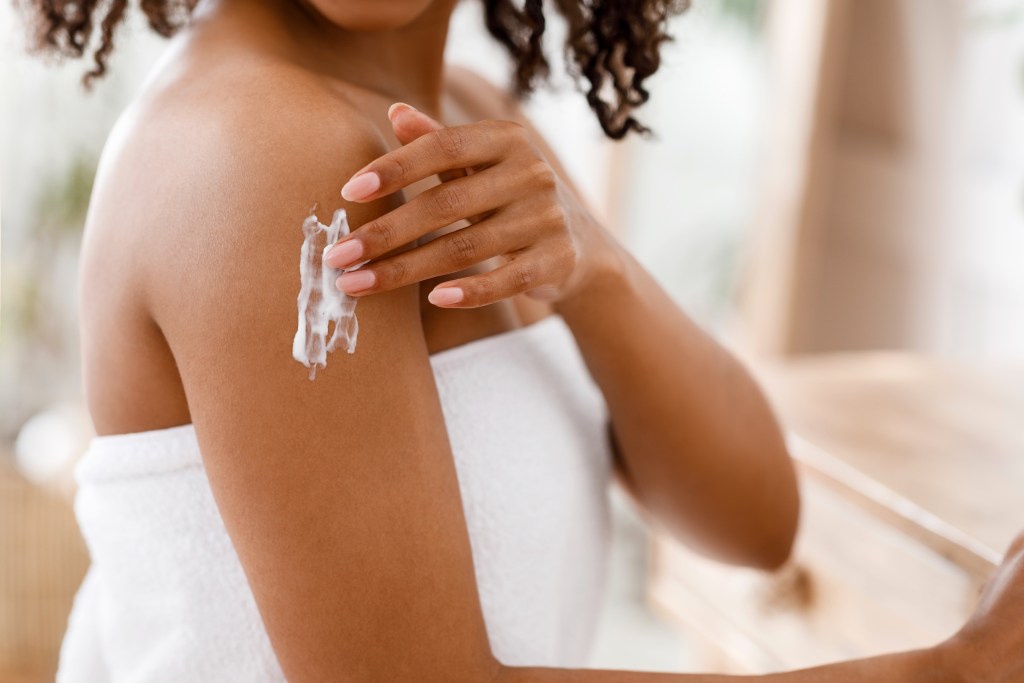At a glance
Keratosis pilaris, also called chicken skin, causes rough, bumpy patches that often affect the arms, thighs, and cheeks. Addressing the underlying causes and incorporating natural remedies for keratosis pilaris, including dietary changes to support hormonal balance, can help improve skin texture and appearance over time.
Keratosis pilaris occurs when dead skin cells clog hair follicles, leading to skin discomfort, rough feeling bumps, and redness.
Learn more about the root causes of this chronic skin condition and discover five natural remedies for keratosis pilaris.
What is keratosis pilaris?
Keratosis pilaris is a chronic skin condition characterized by rough patches of raised bumps resembling plucked chicken skin.
It’s a common skin issue, and it’s believed that between 50 and 80 percent of all adolescents and around 40 percent of adults experience this condition at some point in their lives.
Some of the most common keratosis pilaris symptoms include:
- Dry skin
- Skin discomfort
- Clogged pores
- Skin discoloration
- Skin plugs that feel like sandpaper bumps
Although keratosis pilaris is a harmless condition, its appearance can have detrimental psychological effects and lead to low self-esteem.
Keratosis pilaris can appear anywhere there are hair follicles, most commonly affecting the upper arms, thighs, buttocks, and cheeks. Though it’s usually found on the upper arms and legs, keratosis pilaris can also spread to the forearms and down the legs.
Watch the video below to learn about the best remedy for keratosis pilaris.
Causes and risk factors
Researchers consider the cause of keratosis pilaris to be multifaceted. However, the consensus is that keratosis pilaris is caused by a buildup of keratin on the skin.
Normal skin sloughs off dead cells, reducing excess keratin on the skin’s surface. In those affected with keratosis pilaris, excess keratin can clog hair follicles, contributing to bumpy patches and pustules.
Research published in the International Journal of Trichology suggests that keratosis pilaris may be linked to defective hair shaft formation. According to the study, thicker, circular hair shafts can rupture follicle cells, contributing to abnormal keratin buildup.1
While more research is needed, other potential causes of keratosis pilaris have been suggested.
Here are six risk factors associated with keratosis pilaris.
1. Vitamin A deficiency
Vitamin A deficiency is associated with an increased risk of various skin conditions, including acne, eczema, and keratosis pilaris.
According to a study published in the American Journal of Pathology, “An acquired increase in the incidence of keratosis pilaris-like lesions is observed in obesity, diabetes, pregnancy, menopause, and malnutrition, particularly in association with vitamin A deficiency.”2
2. Hormonal imbalances
Hormonal shifts may play a role in the appearance of keratosis pilaris.
Evidence published in the British Journal of Dermatology observed a correlation between keratosis pilaris and elevated androgen levels, particularly among women with certain hormone-related conditions.3
This suggests that hormonal fluctuations may influence skin texture in some individuals.
3. Poor metabolic health
Obesity and insulin resistance may also play a role in the development of keratosis pilaris.
A study published in Dermatology and Therapy showed that keratosis pilaris is common in obese individuals and concluded that skin conditions were a reliable indicator for insulin resistance.4

4. Weather changes
Keratosis pilaris typically worsens during winter when the air is dry and improves in the summer.
Research published in the British Journal of Dermatology showed that 47 percent of participants with keratosis pilaris experienced heightened symptoms in the winter, and 49 percent of cases improved during summer when the air contained higher humidity.5
5. Genetic predisposition
Keratosis pilaris may have a genetic link.
A study published in Molecular Medicine Reports found that keratosis pilaris is an autosomal dominant-inherited disease passed down from parents to their children. Children with parents who have certain genetic polymorphisms have a 50 percent chance of inheriting the condition.6
6. Age
Keratosis pilaris primarily develops during childhood, peaks during puberty, and may persist into the second decade of life. However, it typically resolves independently once a person reaches their 30s.

6 best natural remedies for keratosis pilaris
Though keratosis pilaris is a superficial skin condition, it leaves skin feeling dry and uncomfortable and can significantly affect an individual’s self-esteem.
Luckily, various remedies can help smooth the skin and relieve discomfort.
Here are five natural remedies that help support healthy skin.
1. Dry brushing
Dry brushing is a manual alternative to chemical exfoliants, such as salicylic acid and glycolic acid. Natural bristle brushes are used for gentle exfoliation to unplug the hair follicle and smooth skin.
Before you shower, brush your skin with a soft-bristled brush in light sweeping motions. Then, shower and hydrate the skin with a natural oil.
2. Exfoliating with sea salt
Exfoliating with sea salt can help slough off dead skin and retain moisture in the skin barrier.
One study published in Skin Research and Technology showed that sea salt helped improve skin dryness in as little as two weeks of regular application.7
You can make a homemade body scrub with sea salt, coconut oil, honey, and essential oils for hydration and gentle exfoliation.

3. Use moisturizing cleansers
Harsh cleansers with perfumes, dyes, and alcohol may dry skin and worsen keratosis pilaris.
Opt for soaps or cleansers with natural moisturizers like olive oil, aloe vera, or jojoba oil. Natural soaps gently cleanse and remove dead skin cells while supporting the skin’s hydration and barrier function.
4. Natural moisturizers
Moisturize damp skin with natural oils after exfoliating and showering to support skin hydration. Avocado oil is a natural moisturizer rich in vitamin A that promotes optimal skin barrier function.
Coconut oil is also widely used to help nourish and cleanse dry skin and is a natural source of skin-supporting antioxidants.
According to a study published in Evidence-Based Complementary and Alternative Medicine, virgin coconut oil supported skin hydration and barrier function more effectively than mineral oil in children with skin discomfort.8
5. Consume plenty of anti-inflammatory foods
Following a keratosis pilaris diet, rich in nutritious anti-inflammatory foods, may help improve skin texture and reduce redness.
Vegetables, berries, and organic meats are rich sources of antioxidants, vitamins, and minerals that support healthy skin function and appearance.
Here’s a list of some of the best anti-inflammatory foods:
- Green leafy vegetables
- Avocados
- Nuts and seeds
- Salmon
- Sardines
- Mackerel
- Extra virgin olive oil
- Turmeric
- Ginger
- Garlic
- Green tea
In addition, foods rich in omega-3 fatty acids, such as tuna, salmon, and sardines, can also mitigate inflammation and support healthy skin.
Furthermore, incorporating vitamin A-rich foods, including grass-fed butter, eggs, organ meats, and organic dairy, can help support healthy vitamin A stores linked to better skin health.

Keratosis pilaris prevention tips
Preventing keratosis pilaris may be impossible without identifying and addressing the underlying cause. However, flare-ups can be minimized with supportive care and lifestyle adjustments.
Here are five practical tips that may help reduce irritation and support smoother skin.
1. Avoid shaving or waxing
Shaving and waxing areas affected by keratosis pilaris can worsen skin bumps and irritation.
Women with keratosis pilaris on their legs and men affected by bumpy skin patches on their faces may find it difficult to avoid shaving. If you must shave, a single-blade razor offers a closer shave and may help reduce skin irritation.
2. Wear loose clothing
Clothes that are too tight or made of a rough material can cause friction and further irritate the skin. It’s recommended to wear loose, breathable clothing made from softer fabrics, such as cotton or linen.
3. Avoid scrubbing
A physical exfoliator can gently exfoliate dead skin and improve the look and feel of keratosis pilaris. However, scrubbing with harsh abrasive cleansers or overusing chemical exfoliators can leave sensitive skin raw.
Gently exfoliate the affected area weekly with dry brushing to remove dead skin without irritation.
4. Take warm showers
Long, hot showers can strip skin of natural oils and make keratosis pilaris worse. Most dermatologists recommend showering for no more than ten minutes using lukewarm water.
5. Use a humidifier
Keratosis pilaris can worsen in the winter and in dry climates. Humidifiers add moisture to the air, which helps hydrate the skin and minimize flare-ups.
Key takeaways
- Keratosis pilaris develops when excess keratin clogs hair follicles, resulting in small, rough bumps.
- Factors such as vitamin A deficiency, hormonal changes, and dry weather can worsen symptoms.
- Gentle exfoliation, such as dry brushing or using sea salt, can help remove dead skin and unclog pores.
- Using natural oils, including coconut or avocado oil, helps moisturize and support the skin barrier.
- Prioritizing anti-inflammatory foods such as leafy green vegetables, oily fish, and turmeric can nourish the skin from within.
FAQ
1. How do I cure my keratosis pilaris naturally?
While there’s no known cure for keratosis pilaris, many people find that gentle skincare and dietary changes can help support smooth, healthy-looking skin.
Exfoliating once a week can also help remove dead skin cells and encourage cell turnover. Moisturizing daily with avocado, jojoba, or virgin coconut oil may help promote softer skin and support moisture retention.
2. Is keratosis pilaris caused by a vitamin deficiency?
There may be a connection between dietary vitamin A intake and how the skin maintains its texture, as this fat-soluble vitamin supports normal keratin production and healthy skin renewal.
3. What is the root cause of keratosis pilaris?
Keratosis pilaris is thought to result from excess keratin blocking hair follicles. It may be influenced by factors such as genetics, skin texture, hormone balance, and overall health.
4. How do you prevent keratosis pilaris?
It may not be possible to prevent keratosis pilaris without identifying and addressing the root cause. However, you can minimize flare-ups by avoiding shaving, waxing, and taking hot baths or showers, as this can irritate the skin and exacerbate dryness.
Wearing loose clothing, avoiding scrubbing, and using a humidifier may also help minimize flare-ups.
Sources
- https://pmc.ncbi.nlm.nih.gov/articles/PMC6102636/ ?
- https://pmc.ncbi.nlm.nih.gov/articles/PMC5336429/ ?
- https://pubmed.ncbi.nlm.nih.gov/3293647/ ?
- https://pmc.ncbi.nlm.nih.gov/articles/PMC4518179/ ?
- https://pubmed.ncbi.nlm.nih.gov/8011494/ ?
- https://pmc.ncbi.nlm.nih.gov/articles/PMC4380844/ ?
- https://pubmed.ncbi.nlm.nih.gov/12535281/ ?
- https://pmc.ncbi.nlm.nih.gov/articles/PMC3681106/ ?














